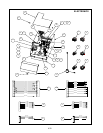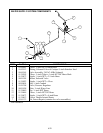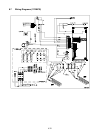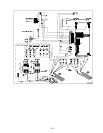
7-1
ELECTRIC COOKER MODELS 17EC, 17ECS, ESW AND EWBS
CHAPTER 7: ESW & EWBS SERVICE PROCEDURES & PARTS
7.1 Functional Description
The ESW series was the predecessor to the EWBS series. Both cookers are very similar in
construction and function. The cookers in the ESW series have rocker-switch controls only. These
cookers were configured as single units or as batteries of two units. The primary difference between
the two configurations is in the piping of the Autofill water supply system and the lack of the basket
lift and computer options on ESW units.
Cookers in the EWBS series may be configured with computer controls or with the rocker-switch
controls as used on the ESW cookers. E1WBS models consist of a single cooker. E2WBS models
consist of two single units battered together.
All models feature a 16.5-gallon (62.5-liter) stainless steel cookpot. The water in the cookpot is
heated by a 13-kilowatt heating element. Optional features include a swing-away jointed faucet and
automatic filling and skimming features (Autofill and Autoskim).
Units with Manual Controls (rocker-switches and a thermostat)
When the POWER switch is placed in the ON position, the white POWER indicator next to the
switch illuminates. If the red TROUBLE indicator illuminates at any time, there is a problem with
the high-limit thermostat. The unit will not heat until the problem with the high-limit thermostat has
been resolved. Anytime the POWER switch is in the ON position, logic circuits in the interface
board check for the presence of water in the cookpot. These circuits look for grounding of the water
level sensors caused by their contact with water in the cookpot.
If the interface board senses that the cookpot is not full, (i.e., the upper water level sensor is not in
contact with water) it signals the normally closed solenoid valve on the water supply line to open.
When the interface board senses that water level in the cookpot is full, (i.e., water contacts the upper
water-level sensor), it signals the solenoid valve to close. Anytime the water level in the cookpot
drops below the upper water-level sensor, the interface board signals the solenoid valve to open to
refill the cookpot to the proper level.
When the HEAT CYCLE switch is placed in either the BOIL or the SIMMER position, if water is in
contact with the lower water level sensor, the interface board signals the contactor coil to close,
energizing the heating element. If the switch is placed in the SIMMER position, the interface board
closes or opens the contactor coil (and thus energizes or de-energizes the element) to maintain the
water in the cookpot at the temperature set with the thermostat knob. If the switch is placed in the
BOIL mode, the element remains energized until the switch is placed in the IDLE or the SIMMER
mode. If the switch is placed in the IDLE mode, power is supplied to all components of the unit
except the heating element. The Autofill feature, the faucet switch, and the skim switch are
functional anytime the power switch is in the ON position, regardless of the position of the heat
cycle switch.


















